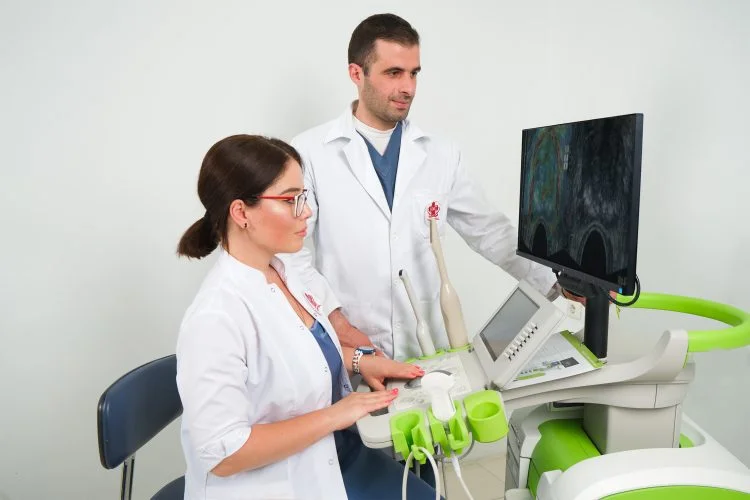What is a biopsy, is it dangerous or painful, how is it performed, and in which cases? These are just a few of the questions that concern most people. It can be said that, just like any other term related to oncology, the word ‘biopsy’ also scares most people.
In reality, a biopsy is a routine examination widely used in diagnostics to determine the nature of damage to different organs. A biopsy is crucial in determining the treatment strategy.
At Karazanashvili Robotic Center, biopsies are performed for the prostate, kidney, testicles, penis, thyroid gland, breast, cervix, and more. It is noteworthy that the innovation at Guram Karazanashvili’s Urological Hub in the region is micro-ultrasound, which is used for targeted (core) biopsies and fusion (Fusion) biopsies. Fusion biopsy is a state-of-the-art method for screening and accurate diagnosis of prostate diseases.
What is a Biopsy?
A biopsy is a medical procedure that is used to detect oncological diseases in a timely manner. It involves the removal of tissue from the affected area and its analysis. The results of the biopsy either rule out or confirm the presence of harmful processes in the human body.
When is it Prescribed?
A biopsy is performed when radiological and laboratory tests are unable to confirm a diagnosis. The procedure allows the doctor to examine cells directly through microscopic analysis. According to the latest recommendations from the European Urology Association, the threshold for normal PSA levels has changed. Now, a PSA level is considered normal if it does not exceed 2 ng/mL (previously, a PSA level between 0 and 4 ng/mL was considered normal). Therefore, if the PSA is within the normal range, prostate cancer is unlikely.
However, it should be noted that if the PSA level exceeds 2 ng/mL, this does not automatically indicate the need for prostate cancer or prostate biopsy. A prostate biopsy is performed in the following cases:
- If the PSA is greater than 2 ng/mL and, at the same time, suspicious areas for cancer are detected in the prostate through micro-ecoscopic examination.
- If the PSA level exceeds 4 ng/mL.
How is it Done?
During a biopsy, a small tissue sample is taken from the human body for examination. This process is called a puncture. The tissue sample obtained through the biopsy undergoes histological or cytological analysis, and based on the results, the doctor determines the treatment methods: surgical intervention, hormone therapy, or multimodal treatment.
Types of Biopsy:
The types of biopsies differ based on which organ is being examined. The size of the biopsy needle also varies depending on the target organ. The procedure may be performed under the control of either ultrasound or computed tomography, depending on which organ is being investigated.
- Aspiration fine-needle biopsy
- Core needle biopsy
- Open, or surgical biopsy
- Laparoscopic biopsy
- Endoscopic biopsy
And, as mentioned, the new global standard for prostate biopsy – targeted (core) biopsy using the ExactVu micro-ultrasound device, which is fast and painless; at this stage, it is only performed at Karazanashvili Robotic Center in the country and region.
Targeted Biopsy:
Targeted biopsy, in turn, is further divided into several types:
- Targeted (core) biopsy under micro-ultrasound control
- “Fusion” biopsy – simultaneous control using Magnetic Resonance Imaging (MRI) and standard ultrasound
- State-of-the-art “Fusion” biopsy – simultaneous control using Magnetic Resonance Imaging (MRI) and micro-ultrasound
The “Fusion” biopsy, this most precise and advanced method, combines micro-ultrasound and MRI data on the ExactVu micro-ultrasound platform and provides a completely new level of resolution, ensuring 100% diagnostic accuracy for prostate cancer, specifically:
- Highly precise differentiation of suspicious tissue
- Highly precise visualization of suspicious regions
- Highly accurate targeting of suspicious areas
- Real-time performance of targeted biopsy
Prostate “Fusion” biopsy (FusionVu) ensures 100% diagnostic accuracy for prostate cancer, eliminates blind and unnecessary biopsies, saves your time and financial resources, and guarantees the most precise diagnosis and effective treatment!

From Which Organs Is It Possible to Take a Sample?
Tissue samples for examination can be taken from almost any organ in the body. Based on the results of the examination, the type of pathology is determined, for example, whether it is functional or structural. In cases where the diagnosis has already been made, a biopsy can help determine the severity and stage of the condition, such as the aggressiveness of cancer.
Is the Procedure Painful?
In most cases, it is painless. However, this depends on which organ the sample is being taken from. During the procedure, the patient may experience mild, monotonous pain, which can be alleviated with painkillers, of course, as recommended by the doctor. For additional information, see the link.
How Long Does It Take to Receive the Results?
It takes a few days to receive the results, however, it is difficult to predict this in advance, as additional tests may be required on the biopsy sample after the initial examination.







